An Overview of Economic Analysis and Environmental Impacts of Natural Gas Conversion Technologies
Abstract
1. Introduction
2. Natural Gas Conversion Technologies
3. Economic Analysis of Natural Gas Conversion Technologies
3.1. Emerging Technologies
3.1.1. Thermal Decomposition of Methane
3.1.2. Other Emerging Technologies for Natural Gas Reforming
3.2. Well Established Technologies
Steam Methane Reforming
4. Environmental Impact of Natural Gas Conversion Technologies
5. Effect of Operating Parameters on the CO2 Emissions and Process Economics
6. Conclusions and Research Outlook
Author Contributions
Funding
Acknowledgments
Conflicts of Interest
Abbreviations/Symbols
| ATR | Auto-thermal methane reforming |
| CAPEX | Capital Expenditure |
| CCS | Carbon Capture and Storage |
| CLR | Chemical Looping reforming |
| CO2 | Carbon dioxide |
| DPBP | Discounted payback period |
| OPEX | Operating Expenditure |
| H2 | Hydrogen |
| IRR | Internal rate of return |
| Kg | Kilogram |
| SMR | Steam methane reforming |
| SCL | Syngas chemical looping |
| NPV | Net profit value |
| MMSCFD | Million standard cubic feet per day |
| TcF | Trillion cubic feet |
| EUR | Euro |
| USD | US dollar |
References
- Leung, G.C.K. Natural Gas as a Clean Fuel. In Handbook Clean Energy Systems; American Cancer Society: Atlanta, GA, USA, 2015; pp. 1–15. [Google Scholar] [CrossRef]
- Steele, B.C.H. Running on natural gas. Nature 1999, 400, 619–621. [Google Scholar] [CrossRef]
- Faramawy, S.; Zaki, T.; Sakr, A.A.-E. Natural gas origin, composition, and processing: A review. J. Nat. Gas. Sci. Eng. 2016, 34, 34–54. [Google Scholar] [CrossRef]
- Fadiran, G.; Adebusuyi, A.T.; Fadiran, D. Natural gas consumption and economic growth: Evidence from selected natural gas vehicle markets in Europe. Energy 2019, 169, 467–477. [Google Scholar] [CrossRef]
- Powell, J.B. Natural gas utilization: Current status and opportunities. Catal. Today 2020. [CrossRef]
- Khan, M.I. Policy options for the sustainable development of natural gas as transportation fuel. Energy Policy 2017, 110, 126–136. [Google Scholar] [CrossRef]
- Ogden, J.; Jaffe, A.M.; Scheitrum, D.; McDonald, Z.; Miller, M. Natural gas as a bridge to hydrogen transportation fuel: Insights from the literature. Energy Policy 2018, 115, 317–329. [Google Scholar] [CrossRef]
- Walker, S.B.; Lanen, D.; van Mukherjee, U.; Fowler, M. Greenhouse gas emissions reductions from applications of Power-to-Gas in power generation. Sustain. Energy Technol. Assess. 2017, 20, 25–32. [Google Scholar] [CrossRef]
- Thiruvengadam, A.; Besch, M.; Padmanaban, V.; Pradhan, S.; Demirgok, B. Natural gas vehicles in heavy-duty transportation-A review. Energy Policy 2018, 122, 253–259. [Google Scholar] [CrossRef]
- Gilbert, A.Q.; Sovacool, B.K. Benchmarking natural gas and coal-fired electricity generation in the United States. Energy 2017, 134, 622–628. [Google Scholar] [CrossRef]
- International Energy Agency. World Energy Outlook 2016; International Energy Agency: Paris, France, 2016. [Google Scholar] [CrossRef]
- International Energy Agency. World Energy Outlook 2019; International Energy Agency: Paris, France, 2019. [Google Scholar] [CrossRef]
- Carmona, M.; Feria, J.; Golpe, A.A.; Iglesias, J. Energy consumption in the US reconsidered. Evidence across sources and economic sectors. Renew. Sustain. Energy Rev. 2017, 77, 1055–1068. [Google Scholar] [CrossRef]
- Ayodele, B.V.; Hossain, S.S.; Lam, S.S.; Osazuwa, O.U.; Khan, M.R.; Cheng, C.K. Syngas production from CO2 reforming of methane over neodymium sesquioxide supported cobalt catalyst. J. Nat. Gas Sci. Eng. 2016, 34, 873–885. [Google Scholar] [CrossRef]
- Ayodele, B.V.; Bin Mohd Yassin, M.Y.; Naim, R.; Abdullah, S. Hydrogen production by thermo-catalytic conversion of methane over lanthanum strontium cobalt ferrite (LSCF) and αAl2O3 supported Ni catalysts. J. Energy Inst. 2019, 92, 892–903. [Google Scholar] [CrossRef]
- Ayodele, B.V.; Khan, M.R.; Cheng, C.K. Greenhouse gases mitigation by CO2 reforming of methane to hydrogen-rich syngas using praseodymium oxide supported cobalt catalyst. Clean Technol. Environ. Policy 2016, 1–13. [Google Scholar] [CrossRef]
- LeValley, T.L.; Richard, A.R.; Fan, M. The progress in water gas shift and steam reforming hydrogen production technologies—A review. Int. J. Hydrogen Energy 2014, 39, 16983–17000. [Google Scholar] [CrossRef]
- Ayodele, B.V.; Khan, M.R.; Lam, S.S.; Cheng, C.K. Production of CO-rich hydrogen from methane dry reforming over lanthania-supported cobalt catalyst: Kinetic and mechanistic studies. Int. J. Hydrogen Energy 2016, 41, 4603–4615. [Google Scholar] [CrossRef]
- Dagle, R.A.; Dagle, V.; Bearden, M.D.; Holladay, J.D.; Krause, T.R.; Ahmed, S. An Overview of Natural Gas Conversion Technologies for Co-Production of Hydrogen and Value-Added Solid Carbon Products; (No PNNL-26726, ANL-17/11); Pacific Northwest Natl Lab(PNNL): Richland, WA USA; Argonne Natl Lab(ANL): DuPage, IL, USA, 2017; Volume 65. [CrossRef]
- Gharibi, M.; Zangeneh, F.T.; Yaripour, F.; Sahebdelfar, S. Nanocatalysts for conversion of natural gas to liquid fuels and petrochemical feedstocks. Appl. Catal. A Gen. 2012, 443, 8–26. [Google Scholar] [CrossRef]
- Gür, T.M. Comprehensive review of methane conversion in solid oxide fuel cells: Prospects for efficient electricity generation from natural gas. Prog. Energy Combust. Sci. 2016, 54, 1–64. [Google Scholar] [CrossRef]
- Pirker, G.; Wimmer, A. Sustainable power generation with large gas engines. Energy Convers. Manag. 2017, 149, 1048–1065. [Google Scholar] [CrossRef]
- Alipour-Dehkordi, A.; Khademi, M.H. Use of a micro-porous membrane multi-tubular fixed-bed reactor for tri-reforming of methane to syngas: CO2, H2O or O2 side-feeding. Int. J. Hydrogen Energy 2019, 44, 32066–32079. [Google Scholar] [CrossRef]
- Kathe, M.; Fryer, C.; Sandvik, P.; Kong, F.; Zhang, Y.; Empfield, A.; Fan, L.S. Modularization strategy for syngas generation in chemical looping methane reforming systems with CO2 as feedstock. AIChE J. 2017, 63, 3343–3360. [Google Scholar] [CrossRef]
- Kim, S.; Crandall, B.S.; Lance, M.J.; Cordonnier, N.; Lauterbach, J.; Sasmaz, E. Activity and stability of NiCe@SiO2 multi–yolk–shell nanotube catalyst for tri-reforming of methane. Appl. Catal. B Environ. 2019, 259, 118037. [Google Scholar] [CrossRef]
- Tahir, M.; Tahir, B.; Zakaria, Z.Y.; Muhammad, A. Enhanced photocatalytic carbon dioxide reforming of methane to fuels over nickel and montmorillonite supported TiO2 nanocomposite under UV-light using monolith photoreactor. J. Clean. Prod. 2019, 213, 451–461. [Google Scholar] [CrossRef]
- Hafizi, A.; Rahimpour, M.R.; Hassanajili, S. Calcium promoted Fe/Al2O3 oxygen carrier for hydrogen production via cyclic chemical looping steam methane reforming process. Int. J. Hydrogen Energy 2015, 40, 16159–16168. [Google Scholar] [CrossRef]
- Sastre, D.; Serrano, D.P.; Pizarro, P.; Coronado, J.M. Chemical insights on the activity of La1-xSrxFeO3 perovskites for chemical looping reforming of methane coupled with CO2-splitting. J. CO2 Util. 2019, 31, 16–26. [Google Scholar] [CrossRef]
- Aboosadi, Z.A.; Yadecoury, M.F. Thermally Intensification of Steam Reforming Process by Use of Methane Tri-Reforming: A Review. Int. J. Chem. React. Eng. 2019, 17. [Google Scholar] [CrossRef]
- Angeli, S.D.; Monteleone, G.; Giaconia, A.; Lemonidou, A.A. State-of-the-art catalysts for CH4 steam reforming at low temperature. Int. J. Hydrogen Energy 2014, 39, 1979–1997. [Google Scholar] [CrossRef]
- Nikolaidis, P.; Poullikkas, A. A comparative overview of hydrogen production processes. Renew. Sustain. Energy Rev. 2017, 67, 597–611. [Google Scholar] [CrossRef]
- Sidik, S.M.; Triwahyono, S.; Jalil, A.A.; Majid, Z.A.; Salamun, N.; Talib, N.B.; Abdullah, T.A. CO2 reforming of CH4 over Ni-Co/MSN for syngas production: Role of Co as a binder and optimization using RSM. Chem. Eng. J. 2016, 295, 1–10. [Google Scholar] [CrossRef]
- Aman, D.; Radwan, D.; Ebaid, M.; Mikhail, S.; van Steen, E. Comparing nickel and cobalt perovskites for steam reforming of glycerol. Mol. Catal. 2018, 452, 60–67. [Google Scholar] [CrossRef]
- Sadykov, V.A.; Gubanova, E.L.; Sazonova, N.N.; Pokrovskaya, S.A.; Chumakova, N.A.; Mezentseva, N.V.; Bobin, A.S.; Gulyaev, R.V.; Ishchenko, A.V.; Krieger, T.A.; et al. Dry reforming of methane over Pt/PrCeZrO catalyst: Kinetic and mechanistic features by transient studies and their modeling. Catal. Today 2011, 171, 140–149. [Google Scholar] [CrossRef]
- Gokon, N.; Yamawaki, Y.; Nakazawa, D.; Kodama, T. Kinetics of methane reforming over Ru/γ-Al2O3-catalyzed metallic foam at 650–900 °C for solar receiver-absorbers. Int. J. Hydrogen Energy 2011, 36, 203–215. [Google Scholar] [CrossRef]
- Abdullah, B.; Abd Ghani, N.A.; Vo, D.V.N. Recent advances in dry reforming of methane over Ni-based catalysts. J. Clean. Prod. 2017, 162, 170–185. [Google Scholar] [CrossRef]
- Abdulrasheed, A.; Jalil, A.A.; Gambo, Y.; Ibrahim, M.; Hambali, H.U.; Shahul Hamid, M.Y. A review on catalyst development for dry reforming of methane to syngas: Recent advances. Renew. Sustain. Energy Rev. 2019, 108, 175–193. [Google Scholar] [CrossRef]
- Rategarpanah, A.; Meshkani, F.; Wang, Y.; Arandiyan, H.; Rezaei, M. Thermocatalytic conversion of methane to highly pure hydrogen over Ni–Cu/MgO·Al2O3 catalysts: Influence of noble metals (Pt and Pd) on the catalytic activity and stability. Energy Convers. Manag. 2018, 166, 268–280. [Google Scholar] [CrossRef]
- Kumar, R.; Kumar, K.; Choudary, N.V.; Pant, K.K. Effect of support materials on the performance of Ni-based catalysts in tri-reforming of methane. Fuel Process. Technol. 2019, 186, 40–52. [Google Scholar] [CrossRef]
- Kang, D.; Lim, H.S.; Lee, J.W. Mesoporous Fe2O3–CeO2–Al2O3 Oxygen Carrier for Chemical Looping Dry Reforming with Subsequent Water Splitting. Ind. Eng. Chem. Res. 2020, 59, 15912–15920. [Google Scholar] [CrossRef]
- Chuayboon, S.; Abanades, S.; Rodat, S. Solar chemical looping reforming of methane combined with isothermal H2O/CO2 splitting using ceria oxygen carrier for syngas production. J. Energy Chem. 2020, 41, 60–72. [Google Scholar] [CrossRef]
- Wang, Y.; Zheng, Y.; Wang, Y.; Li, K.; Wang, Y.; Jiang, L.; Zhu, X.; Wei, Y.; Wang, H. Syngas production modified by oxygen vacancies over CeO2-ZrO2-CuO oxygen carrier via chemical looping reforming of methane. Appl. Surf. Sci. 2019, 481, 151–160. [Google Scholar] [CrossRef]
- Henard, C.A.; Smith, H.; Dowe, N.; Kalyuzhnaya, M.G.; Pienkos, P.T.; Guarnieri, M.T. Bioconversion of methane to lactate by an obligate methanotrophic bacterium. Sci. Rep. 2016, 6, 21585. [Google Scholar] [CrossRef]
- Shoji, S.; Peng, X.; Yamaguchi, A.; Watanabe, R.; Fukuhara, C.; Cho, Y.; Yamamoto, T.; Matsumura, S.; Yu, M.W.; Ishii, S.; et al. Photocatalytic uphill conversion of natural gas beyond the limitation of thermal reaction systems. Nat. Catal. 2020, 3, 148–153. [Google Scholar] [CrossRef]
- Aznar-Sánchez, J.A.; Belmonte-Ureña, L.J.; Velasco-Muñoz, J.F.; Manzano-Agugliaro, F. Economic analysis of sustainable water use: A review of worldwide research. J. Clean. Prod. 2018, 198, 1120–1132. [Google Scholar] [CrossRef]
- Jouny, M.; Luc, W.; Jiao, F. General Techno-Economic Analysis of CO2 Electrolysis Systems. Ind. Eng. Chem. Res. 2018, 57, 2165–2177. [Google Scholar] [CrossRef]
- Towler, G.; Sinnott, R.A.Y. Chemical Engineering Design: Principles, Practice and Economics of Plant and Process Design; Elsevier: Amsterdam, The Netherlands, 2013. [Google Scholar] [CrossRef]
- Nikookaran, N.; Karakostas, G.; Todd, T.D. Combining Capital and Operating Expenditure Costs in Vehicular Roadside Unit Placement. IEEE Trans. Veh. Technol. 2017, 66, 7317–7331. [Google Scholar] [CrossRef]
- Qian, J.X.; Chen, T.W.; Enakonda, L.R.; Liu, D.B.; Basset, J.M.; Zhou, L. Methane decomposition to pure hydrogen and carbon nano materials: State-of-the-art and future perspectives. Int. J. Hydrogen Energy 2020, 45, 15721–15743. [Google Scholar] [CrossRef]
- Mueller-Langer, F.; Tzimas, E.; Kaltschmitt, M.; Peteves, S. Techno-economic assessment of hydrogen production processes for the hydrogen economy for the short and medium term. Int. J. Hydrogen Energy 2007, 32, 3797–3810. [Google Scholar] [CrossRef]
- Keipi, T.; Tolvanen, H.; Konttinen, J. Economic analysis of hydrogen production by methane thermal decomposition: Comparison to competing technologies. Energy Convers. Manag. 2018, 159, 264–273. [Google Scholar] [CrossRef]
- Keipi, T.; Hankalin, V.; Nummelin, J.; Raiko, R. Techno-economic analysis of four concepts for thermal decomposition of methane: Reduction of CO2 emissions in natural gas combustion. Energy Convers. Manag. 2016, 110, 1–12. [Google Scholar] [CrossRef]
- Mondal, K.C.; Ramesh Chandran, S. Evaluation of the economic impact of hydrogen production by methane decomposition with steam reforming of methane process. Int. J. Hydrogen Energy 2014, 39, 9670–9674. [Google Scholar] [CrossRef]
- Timmerberg, S.; Kaltschmitt, M.; Finkbeiner, M. Hydrogen and hydrogen-derived fuels through methane decomposition of natural gas—GHG emissions and costs. Energy Convers. Manag. X 2020, 7, 100043. [Google Scholar] [CrossRef]
- Labanca, A.; Feugeas, J.; Miranda, P. Economic Analysis of CO2-Free Hydrogen Production from Natural Gas by Plasma Pyrolysis; Rio Oil & Gas Expo and Conference: Rio de Janeiro, Brazil, 2006; pp. 1–19. [Google Scholar]
- Gaudernack, B.; Lynum, S. Hydrogen from natural gas without release of CO2 to the atmosphere. Int. J. Hydrogen Energy 1998, 23, 1087–1093. [Google Scholar] [CrossRef]
- Khojasteh Salkuyeh, Y.; Saville, B.A.; MacLean, H.L. Techno-economic analysis and life cycle assessment of hydrogen production from natural gas using current and emerging technologies. Int. J. Hydrogen Energy 2017, 42, 18894–18909. [Google Scholar] [CrossRef]
- Godini, H.R.; Xiao, S.; Jašo, S.; Stünkel, S.; Salerno, D.; Son, N.X.; Song, S.; Wozny, G. Techno-economic analysis of integrating the methane oxidative coupling and methane reforming processes. Fuel Process Technol. 2013, 106, 684–694. [Google Scholar] [CrossRef]
- Fei, Q.; Liang, B.; Tao, L.; Tan, E.C.; Gonzalez, R.; Henard, C.; Guarnieri, M. Biological valorization of natural gas for the production of lactic acid: Techno-economic analysis and life cycle assessment. Biochem. Eng. J. 2020, 158, 107500. [Google Scholar] [CrossRef]
- Cantera, S.; Muñoz, R.; Lebrero, R.; López, J.C.; Rodríguez, Y.; García-Encina, P.A. Technologies for the bioconversion of methane into more valuable products. Curr. Opin. Biotechnol. 2018, 50, 128–135. [Google Scholar] [CrossRef]
- Diglio, G.; Hanak, D.P.; Bareschino, P.; Mancusi, E.; Pepe, F.; Montagnaro, F.; Manovic, V. Techno-economic analysis of sorption-enhanced steam methane reforming in a fixed bed reactor network integrated with fuel cell. J. Power Sources 2017, 364, 41–51. [Google Scholar] [CrossRef]
- Zhang, C.; Jun, K.W.; Gao, R.; Kwak, G.; Park, H.G. Carbon dioxide utilization in a gas-to-methanol process combined with CO2/Steam-mixed reforming: Techno-economic analysis. Fuel 2017, 190, 303–311. [Google Scholar] [CrossRef]
- Gangadharan, P.; Kanchi, K.C.; Lou, H.H. Evaluation of the economic and environmental impact of combining dry reforming with steam reforming of methane. Chem. Eng. Res. Des. 2012, 90, 1956–1968. [Google Scholar] [CrossRef]
- Luk, H.T.; Lei, H.M.; Ng, W.Y.; Ju, Y.; Lam, K.F. Techno-economic analysis of distributed hydrogen production from natural gas. Chin. J. Chem. Eng. 2012, 20, 489–496. [Google Scholar] [CrossRef]
- Dufour, J.; Serrano, D.P.; Gálvez, J.L.; Moreno, J.; González, A. Hydrogen production from fossil fuels: Life cycle assessment of technologies with low greenhouse gas emissions. Energy Fuels 2011, 25, 2194–2202. [Google Scholar] [CrossRef]
- Dufour, J.; Serrano, D.P.; Gálvez, J.L.; González, A.; Soria, E.; Fierro, J.L.G. Life cycle assessment of alternatives for hydrogen production from renewable and fossil sources. Int. J. Hydrogen Energy 2012, 37, 1173–1183. [Google Scholar] [CrossRef]
- Dufour, J.; Serrano, D.P.; Gálvez, J.L.; Moreno, J.; García, C. Life cycle assessment of processes for hydrogen production. Environmental feasibility and reduction of greenhouse gases emissions. Int. J. Hydrogen Energy 2009, 34, 1370–1376. [Google Scholar] [CrossRef]
- Dufour, J.; Gálvez, J.L.; Serrano, D.P.; Moreno, J.; Martínez, G. Life cycle assessment of hydrogen production by methane decomposition using carbonaceous catalysts. Int. J. Hydrogen Energy 2010, 35, 1205–1212. [Google Scholar] [CrossRef]
- Srilatha, K.; Bhagawan, D.; Kumar, S.S.; Himabindu, V. Sustainable fuel production by thermocatalytic decomposition of methane—A review. S. Afr. J. Chem. Eng. 2017, 24, 156–167. [Google Scholar] [CrossRef]
- Kothari, R.; Buddhi, D.; Sawhney, R.L. Comparison of environmental and economic aspects of various hydrogen production methods. Renew. Sustain. Energy 2008, 12, 553–563. [Google Scholar] [CrossRef]
- Hamid, U.; Rauf, A.; Ahmed, U.; Selim Arif Sher Shah, M.; Ahmad, N. Techno-economic assessment of process integration models for boosting hydrogen production potential from coal and natural gas feedstocks. Fuel 2020, 266, 117111. [Google Scholar] [CrossRef]
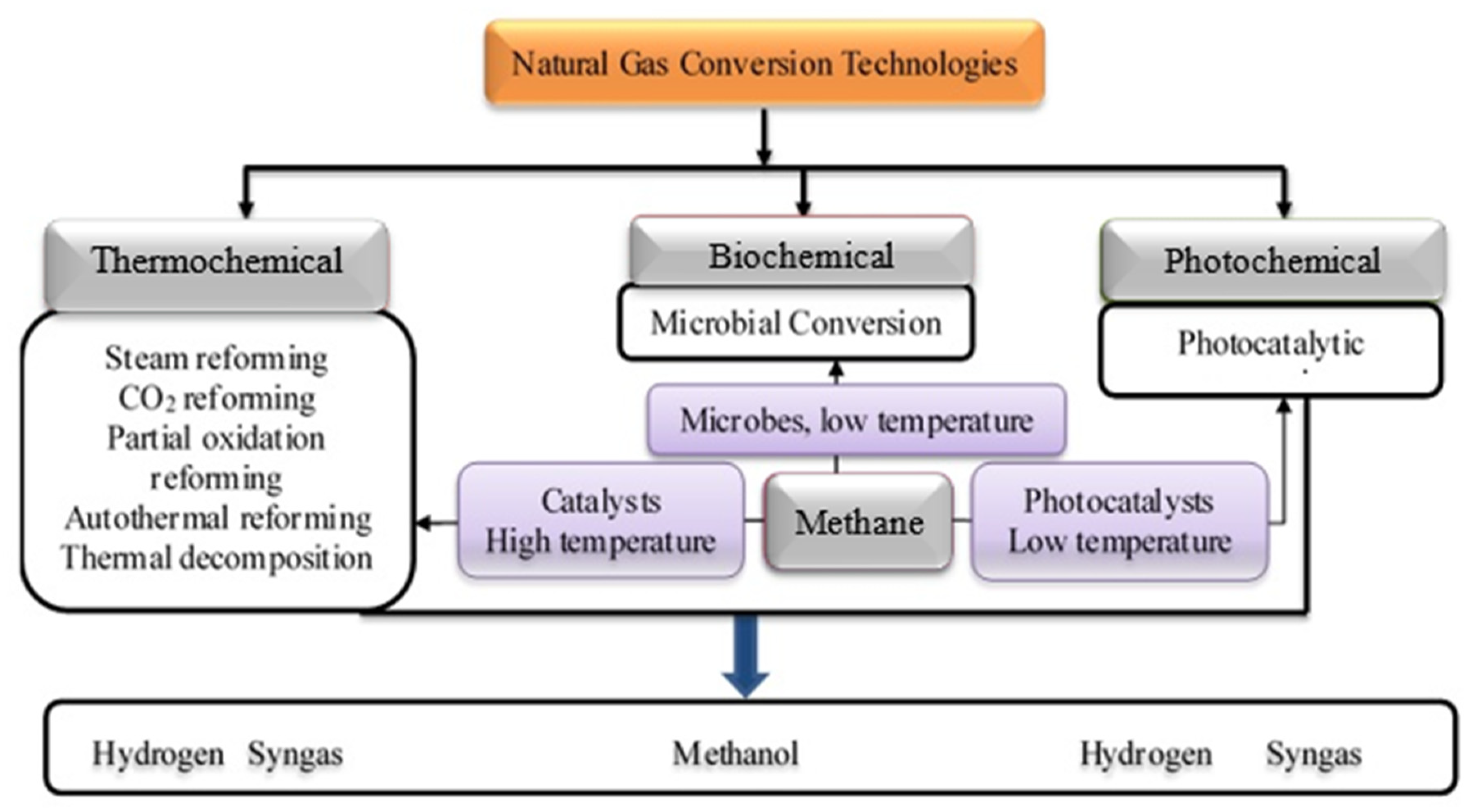
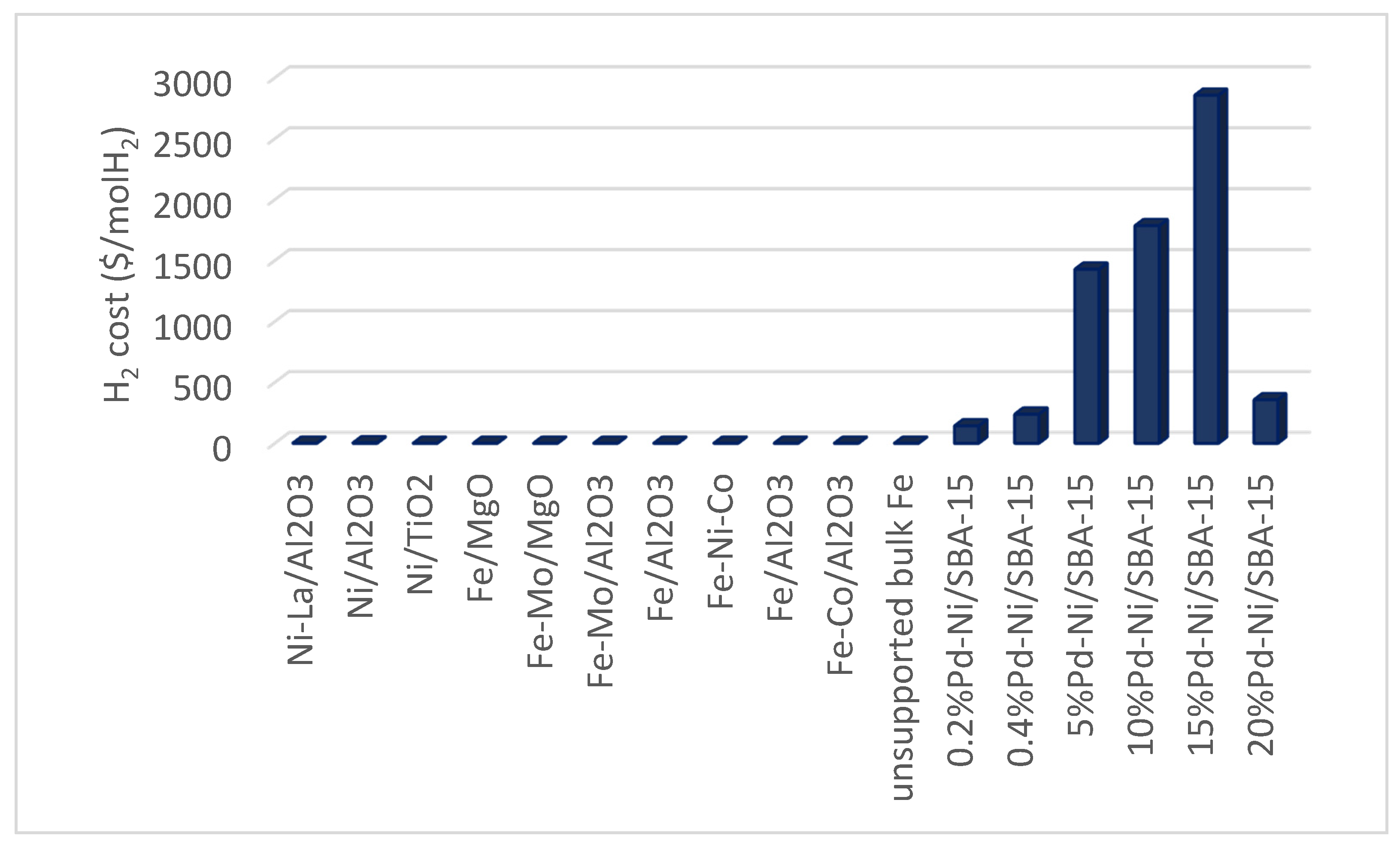
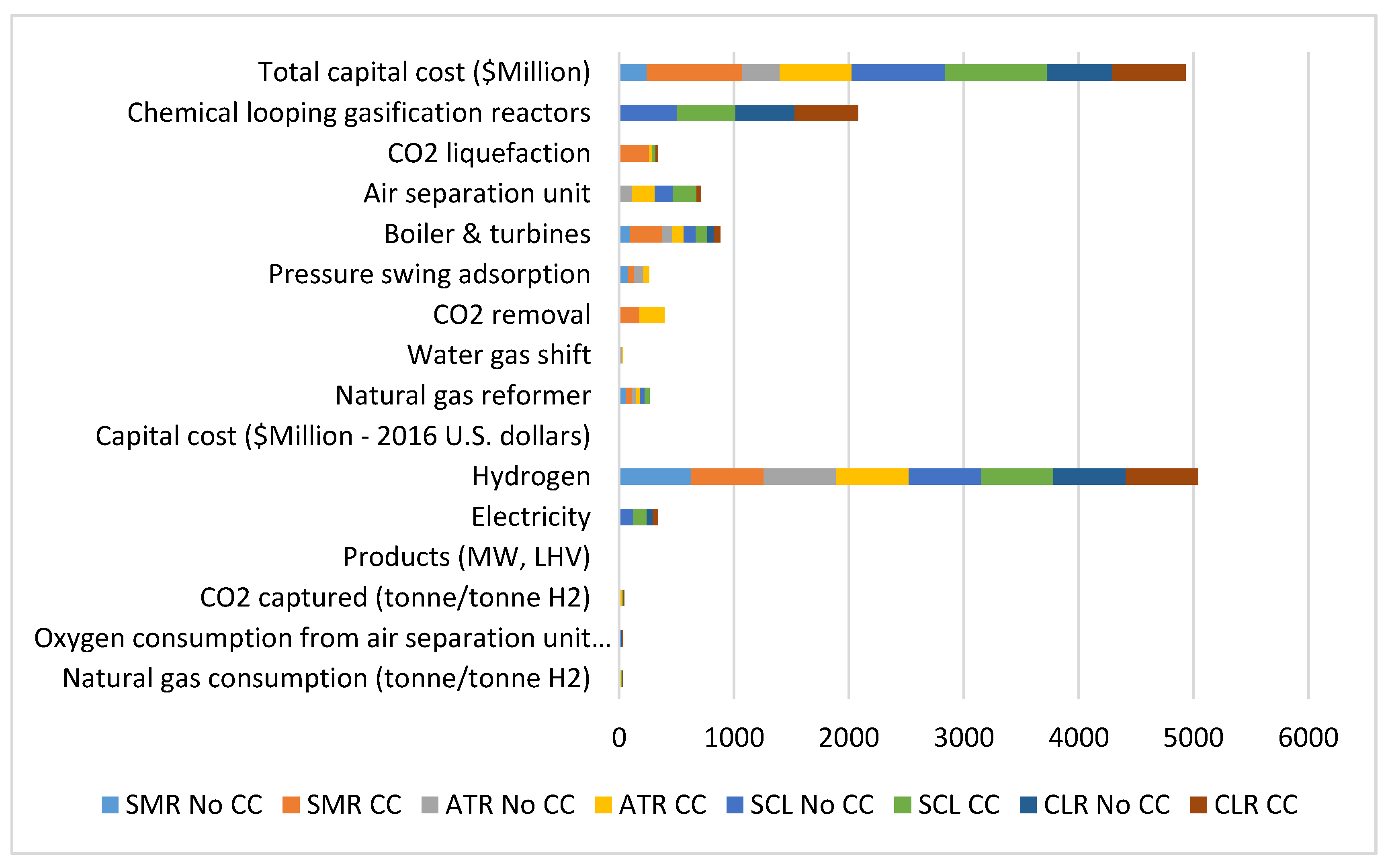
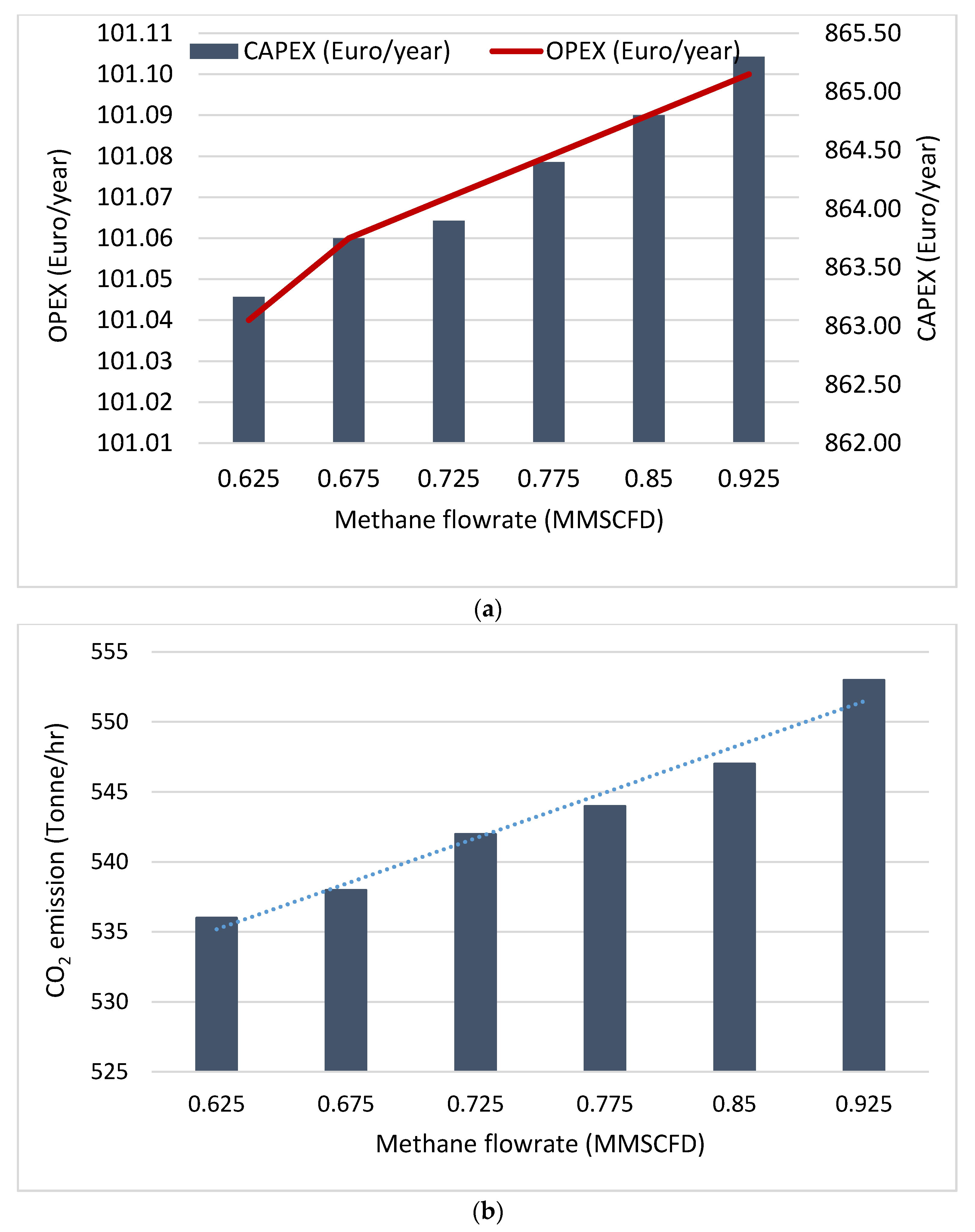
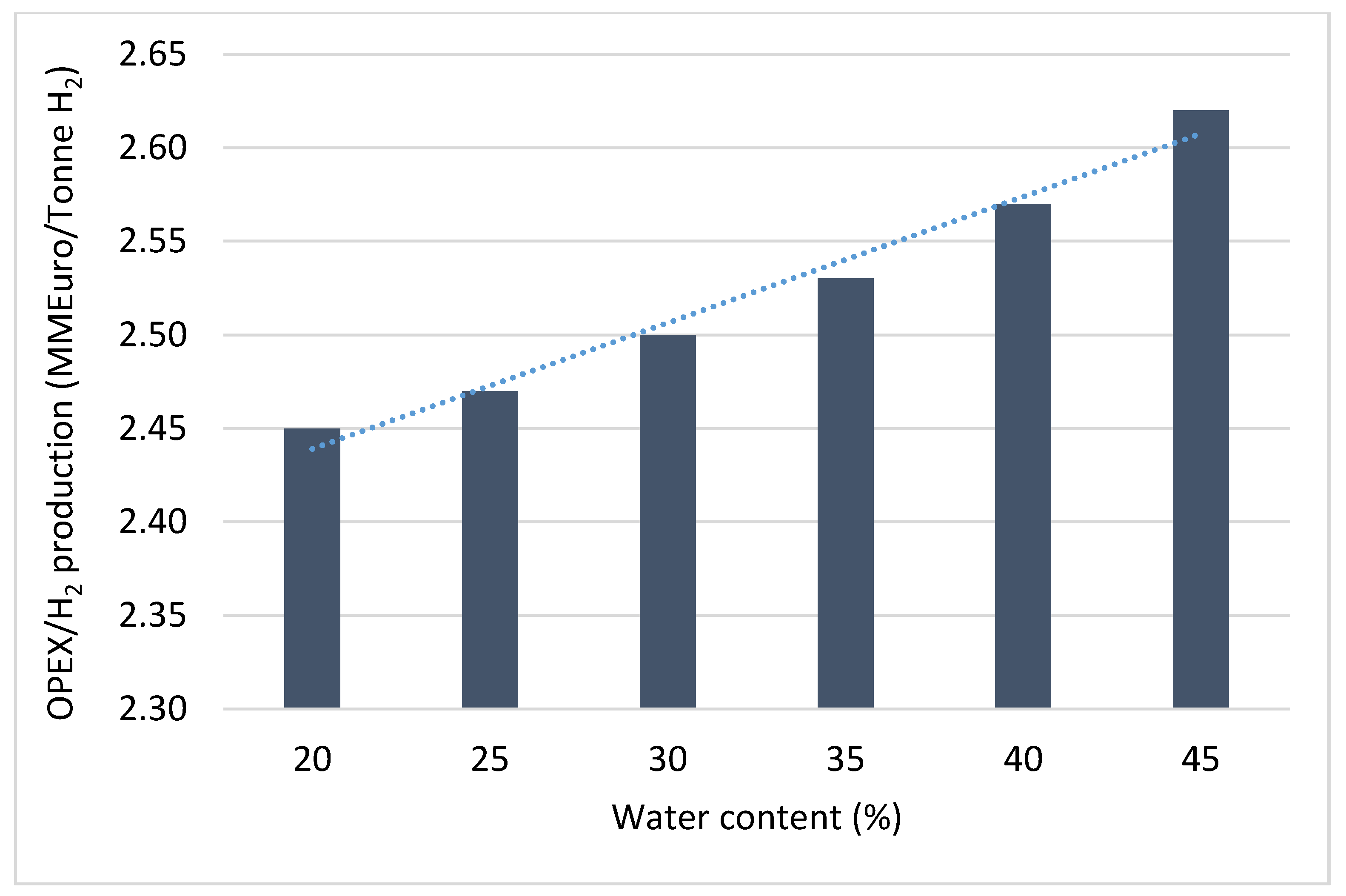
| Technology | Process Output (Products) | Economic Analysis | Environmental Impact | Nature of Technology | References |
|---|---|---|---|---|---|
| Plasma-assisted Methane decomposition | H2, carbon black | Hydrogen production cost EUR 1.6 (USD 1.89)/kg H2 | N.R | Emerging | [54] |
| Methane decomposition using molten reactor | H2, carbon black | Hydrogen production cost EUR 2.2 (USD 2.6)/kg H2 | N.R | Emerging | |
| Plasma pyrolysis of natural gas | H2, carbon black | CAPEX: USD 0.674 million, OPEX: USD 0.228 million, hydrogen production cost: USD 14.36/kg | N.R | Emerging | [55] |
| Steam reforming of natural gas without CO2 capture | H2, CO2 | CAPEX: USD 17.18 million/Nm2 H2, OPEX: USD 4.28 million/Nm2 H2, | N.R | Well Established | [56] |
| Steam reforming of natural gas with CO2 capture | H2 | CAPEX: USD 31.1 million/Nm2 H2, OPEX: USD 5 million/Nm2 H2 | N.R | Emerging | |
| High temperature Pyrolysis of natural gas | H2, carbon black | CAPEX: USD 29.4 million/Nm2 H2, OPEX: USD 14.3 million/Nm2 H2 | N.R | Emerging | |
| Methane thermal decomposition | H2, carbon | H2 production cost: EUR 72 (USD 90)/MWh CAPEX: EUR 4203 (USD 5258) OPEX: EUR 815 (USD 1020) | 40 kgCO2/MWhH2 | Emerging | [51] |
| Steam methane reforming | H2, CO2 | H2 production cost: EUR 117 (USD 146)/MWh CAPEX: EUR 10,705 (USD 13,392) OPEX: EUR 776 (USD 971) | 293 kgCO2/MWhH2 | Well Established | |
| Steam methane reforming with CCS | H2, CO2 | H2 production cost: EUR 57.5 (USD 71.9)/MWh CAPEX: EUR 162,000 (USD 202,662) OPEX: EUR 97,662 (USD 122,175) | 133 kgCO2/MWh H2 | Emerging | |
| Thermal decomposition of methane using energy from partial combustion of methane | H2, carbon | CAPEX: 12,646 (* kEUR) (14,037 kUSD) OPEX: 32,229 (* kEUR) (35,774 kUSD) | 0.55 tCO2/MWhe | Emerging | [52] |
| Thermal decomposition of methane using energy from electricity | H2, carbon | CAPEX: 8225 (* kEUR) (9130 kUSD) OPEX: 32,274 (* kEUR) (35,824.14 kS) | 0.83 tCO2/MWhe | Emerging | |
| Catalytic decomposition of Thermal methane using an energy carrier catalyst | H2, carbon | CAPEX: 28,354 (kEUR) (31,473 kUSD) OPEX: 36,884 (kEUR) (40,941 kUSD) | 0.48 tCO2/MWhe | Emerging | |
| Thermal decomposition of methane using a regenerative heat exchanger reactor | H2, carbon | CAPEX: 10,139 (kEUR) (11,254 kUSD) OPEX: 32,445 (kEUR) (36,014 kUSD) | 0.85 tCO2/MWhe | Emerging | |
| Steam methane reforming | H2, CO2 | N.R | 1.8 kgCO2/Nm2H2 | Well-Established | [65] |
| Autothermal reforming | H2, CO2 | N.R | 0.4 kgCO2/Nm2H2 | Emerging | |
| Autocatalytic decomposition | H2, carbon | N.R | 0.2 kgCO2/Nm2H2 | Emerging | |
| Steam methane reforming with CO2 utilization | Methanol | CAPEX: 1036.21 MUSD, Production cost: 222.35 USD/Mt NPV (ic = 12%): 483.41 IRR: 17.15 DPBP: 9.52 | N.R | Emerging | [62] |
| Combined dry reforming and steam reforming of methane | Syngas (H2 + CO) | CAPEX: USD 21 Million OPEX: USD 5231.82/h | Potential environmental impact: 2.83 × 10−3 PEI/h | Emerging | [63] |
| Standalone Steam methane reforming | H2, CO2 | CAPEX: USD 18 Million OPEX: USD 5308.72/h | Potential environmental impact: 2.83 × 10−4 PEI/h | Well Established | |
| Thermocatalytic methane decomposition with 38% conversion | H2, carbon | Total capital cost: USD 301 million Production cost: USD 948/MT | Reported as low carbon footprint | Emerging | [53] |
| Thermocatalytic methane decomposition with 50% conversion | H2, carbon | Total capital cost: USD 291 million Production cost: USD 899/MT | Reported as moderate carbon footprint | Emerging | |
| Steam methane reforming | H2, CO2 | Total capital cost: USD 326 million Production cost: USD 873/MT | Reported as high carbon footprint | Well Established | |
| Thermal decomposition using carbonaceous catalyst | H2, carbon | N.R | 0.25 kg CO2/Nm2 H2 | Emerging | [66] |
| Thermal decomposition using carbonaceous catalyst (96% conversion) | H2, carbon | N.R | 0.16 kg CO2/Nm2 H2 | Emerging | |
| Thermal decomposition using carbonaceous catalyst (78% conversion) | H2, carbon | N.R | 0.22 kg CO2/Nm2 H2 | Emerging | |
| Steam reforming with carbon capture and utilization | H2 | N.R | 0.32 kg CO2/Nm2 H2 | Emerging | |
| Sorption enhanced Steam reforming | H2, CO2 | CAPEX: EUR 6.31 million Cost of production: EUR 1.6/kg | N.R | Emerging | |
| Steam reforming of methane | H2, CO2 | Minimum H2 price: USD 1.08/kg | 10 kg/kg H2 | Well Established | [57] |
| Autothermal reforming | H2, CO2 | Minimum H2 price: USD 1.0/kg | 9 kg/kg H2 | Emerging | |
| Syngas Chemical looping | H2, CO2 | Minimum H2 price: USD 1.38/kg | 13 kg/kg H2 | Emerging | |
| Chemical looping reforming | H2, CO2 | Minimum H2 price: USD 0.8/kg | 8.6 kg/kg H2 | Emerging | |
| Bioconversion | Lactic acid | Minimum selling price: USD 5.83/kg OPEX: USD 47.0 MM CAPEX: USD 654.96MM | 8.89 kg CO2eq | Emerging | [59] |
| Bioconversion | Ectoine, Bioplastics, Biofuel, Extracellular polysaccharides | OPEX: USD 1021/h Bioproducts values: USD 10,0000/h | 4807 kg CO2/h | Emerging | [60] |
Publisher’s Note: MDPI stays neutral with regard to jurisdictional claims in published maps and institutional affiliations. |
© 2020 by the authors. Licensee MDPI, Basel, Switzerland. This article is an open access article distributed under the terms and conditions of the Creative Commons Attribution (CC BY) license (http://creativecommons.org/licenses/by/4.0/).
Share and Cite
Ayodele, F.O.; Mustapa, S.I.; Ayodele, B.V.; Mohammad, N. An Overview of Economic Analysis and Environmental Impacts of Natural Gas Conversion Technologies. Sustainability 2020, 12, 10148. https://doi.org/10.3390/su122310148
Ayodele FO, Mustapa SI, Ayodele BV, Mohammad N. An Overview of Economic Analysis and Environmental Impacts of Natural Gas Conversion Technologies. Sustainability. 2020; 12(23):10148. https://doi.org/10.3390/su122310148
Chicago/Turabian StyleAyodele, Freida Ozavize, Siti Indati Mustapa, Bamidele Victor Ayodele, and Norsyahida Mohammad. 2020. "An Overview of Economic Analysis and Environmental Impacts of Natural Gas Conversion Technologies" Sustainability 12, no. 23: 10148. https://doi.org/10.3390/su122310148
APA StyleAyodele, F. O., Mustapa, S. I., Ayodele, B. V., & Mohammad, N. (2020). An Overview of Economic Analysis and Environmental Impacts of Natural Gas Conversion Technologies. Sustainability, 12(23), 10148. https://doi.org/10.3390/su122310148





